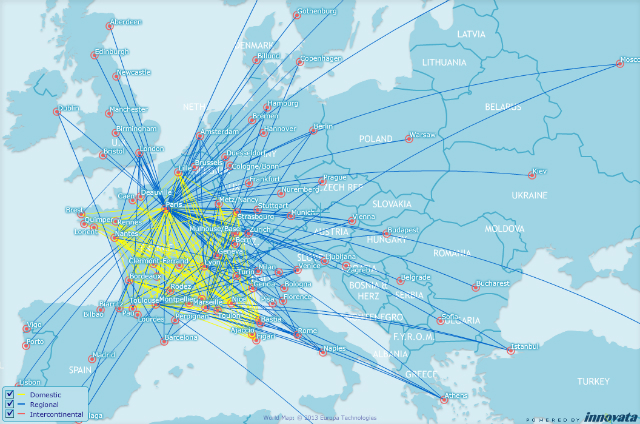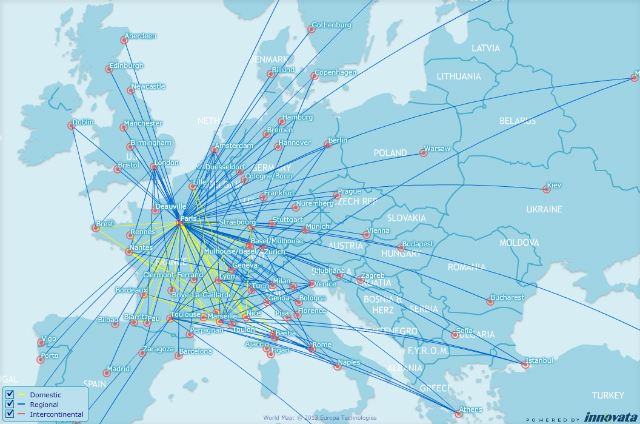It comes as no great surprise that Alexandre de Juniac described the restructuring of short- and medium-haul operations at Air France-KLM as "insufficient" after the latest financial loss at the group was announced.
His predecessor as chief executive of Air France-KLM, Jean-Cyril Spinetta, had already identified those operations as "priority number one" while discussing the group's restructuring in July 2012.
Nor is it a secret that Air France, particularly, is haemorrhaging money. Results filed with France's national companies registry in June show that Air France's passenger operations racked up a €985 million ($1.3 billion) pre-tax loss last year. The consolidated group loss was less than 20% higher, at €1.19 billion.
However, while a group loss of €163 million for 2013's second quarter adds weight to de Juniac's assessment that deeper cost-cutting is needed, efforts to restructure the short- and medium-haul business have already started to bear fruit.
De Juniac says that capacity was reduced in France and across Europe, leading to an improvement in the financial performance of the group's short- and medium-haul operations. In France, the quarter's 4.8% reduction in capacity was accompanied by a 2.3% increase in revenue passenger-kilometres and there was a 1.4% increase in revenue per available seat-kilometre (RASK).
The extent to which Air France has revamped its medium-haul offering since last summer is highlighted by Innovata data which shows that Air France is offering some 19,600 narrowbody and regional aircraft flights from France this month, compared with around 21,300 last year.
 |
|---|
Innovata FlightMaps Analytics |
Air France route map for July 2012 |
 |
|---|
Innovata FlightMaps Analytics |
Air France route map for July 2013 |
To reduce capacity, the French flag carrier reduced its Airbus A320 fleet to 119 aircraft from 135 in the summer of 2012, and removed 15 regional aircraft from the fleet flown by Hop.
Since last summer, it has pulled seven medium-haul routes, including Milan and Hamburg from Marseille and Milan and Vienna from Toulouse.
Air France's three-pronged strategy to address its medium-haul problems were last year organised around three units: its provincial bases, regional business division and low-cost subsidiary Transavia. It has been growing the fleet of Transavia and experimenting with taking over flights operated by its parent carriers on "highly competitive routes", while three of its regional carriers - Brit Air, Régional and Airlinair - were merged to form Hop in January. Excluded from this was CityJet, which posted a loss of €196 million during 2012.
The SkyTeam carrier retains services feeding the Charles de Gaulle hub, alongside routes with a high density of business customers and flights departing from its regional bases in Marseille, Toulouse and Nice. However, demand for services from the regional bases - expected to generate €950 million a year in revenue - has fallen below target. Changes will be made in September, after a review of operations is complete. Cuts in routes and aircraft are likely.
Air France-KLM leisure subsidiary Transavia is to take on more medium-haul leisure destinations served by Air France after a successful test on four routes, says its French arm's chief executive Antoine Pussiau.
He describes the arrangement under which services to Tunis, Naples, Venice and Lisbon are shared between the two airlines - and marketed by both - as a "wing-to-wing" partnership. Flightglobal Pro data shows that of the six weekly Transavia France flights to Tunisia's capital from Paris Orly, one is operated by Air France and the other five by the leisure carrier.
"There are some markets which are really fitting our network, which are leisure point-to-point [and] which we could operate without jeopardising the business of Air France - which is mainly done in Paris Charles de Gaulle as part of its connections with long-haul," he says.
Speaking earlier this month at the French Connect 2013 conference in Bordeaux, Pussiau explained that "we decided to launch these routes for it [Air France] to be on the market and obviously to keep this market in Air France-KLM instead of letting it go to some competitors".
He says the four routes were "done as a test and, as the results are quite positive, we hope we will be able to add new 'wing-to-wing' leisure routes". However, he adds: "This has to be done in agreement with Air France - and especially the unions in Air France - so it is not so easy."
Growth in leisure services from French regional airports is where Pussiau sees most potential for expansion for his airline and where he feels its low unit costs could help the Air France-KLM group compete for leisure traffic with the likes of EasyJet, Ryanair, Volotea and Vueling. In order to do so, he says, the airline is growing its fleet by "three or four airplanes per year. This year we are adding three airplanes so we now are at 11, next year we have already ordered three so it will be 14, and then we will be around 20-22 [aircraft] by 2016."
Source: Air Transport Intelligence news



















